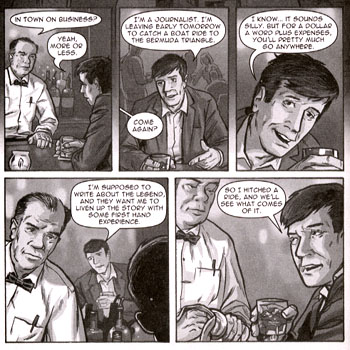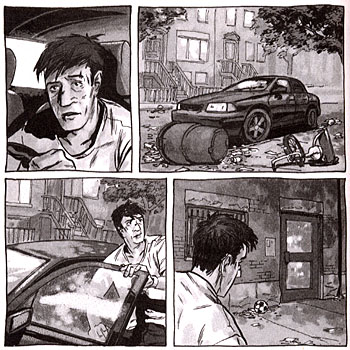 Written by Neal Shaffer
Written by Neal Shaffer
Art by Joe Infurnari
80 pages, black and white
Published by Oni Press
The pacing of a story—be it serialized or as a single, complete unit—is important. The right sort of pacing can draw a reader into your book, but just as easily alienate them. When I’ve read comics in the past by Neal Shaffer, they’ve been either serialized as 32-page comics, or as full-fledged graphic novels. With Borrowed Time and its 80-page format, I couldn’t help but wonder just how Shaffer’s very distinct sense of pacing would translate. On paper, his new series about the Bermuda Triangle and the ultimate destination of things we lose sounds perfect for the format; but what would the end result actually be?
Taylor Devlin is a freelance journalist who will travel just about anywhere for a story. When a good-paying article is offered up to Taylor, he doesn’t think twice about agreeing to travel into the legendary Bermuda Triangle to experience it first-hand. Upon entering, though, Taylor is about to discover that some legends have substance behind them, and not taking them seriously can have grave consequences.
 For some books, you can read the pre-publication hype and description, and still have plenty of surprises waiting in store for you. With the first volume of Borrowed Time, that’s unfortunately not the case. Almost everything used to promote the series gives away all of the big twists and turns of this installment, and the end result is more than a little bit of disappointment for people who had gotten turned on by the advance word. It wasn’t until I went back and re-read Borrowed Time that I really began to figure out what the problem was; the pacing just seems a little off for the format. It’s interesting, because I’ve read similarly slow-paced books from Shaffer in the past (Last Exit Before Toll, The Awakening) and really enjoyed them. The difference, I think, is that those books were complete entities in their own right, moving you forward all the way to a conclusion in one large chunk. With Borrowed Time, that’s not the case, there are more installments to come. So when Shaffer writes in his trademark style that lets things unfold at a gradual pace until they envelop the reader, the full effect isn’t quite realized. He’s creating a beautiful set-up for lots of things to come that haven’t actually arrived, and it’s frustrating because it’s clearly just the tip of the iceberg. We just aren’t quite there yet, so when the first act comes to a close the reader is left hanging after getting sufficiently worked up.
For some books, you can read the pre-publication hype and description, and still have plenty of surprises waiting in store for you. With the first volume of Borrowed Time, that’s unfortunately not the case. Almost everything used to promote the series gives away all of the big twists and turns of this installment, and the end result is more than a little bit of disappointment for people who had gotten turned on by the advance word. It wasn’t until I went back and re-read Borrowed Time that I really began to figure out what the problem was; the pacing just seems a little off for the format. It’s interesting, because I’ve read similarly slow-paced books from Shaffer in the past (Last Exit Before Toll, The Awakening) and really enjoyed them. The difference, I think, is that those books were complete entities in their own right, moving you forward all the way to a conclusion in one large chunk. With Borrowed Time, that’s not the case, there are more installments to come. So when Shaffer writes in his trademark style that lets things unfold at a gradual pace until they envelop the reader, the full effect isn’t quite realized. He’s creating a beautiful set-up for lots of things to come that haven’t actually arrived, and it’s frustrating because it’s clearly just the tip of the iceberg. We just aren’t quite there yet, so when the first act comes to a close the reader is left hanging after getting sufficiently worked up.
Ironically, this wouldn’t be noticeable if this first volume of Borrowed Time was a bad book; it’s actually anything but. Shaffer creates a realistic and understandable protagonist in the form of Taylor, and when we meet him Shaffer makes sure that we understand exactly what his life is like before it’s all taken away from him. The scenes aboard the Borrowed Time are sufficiently creepy and eerie as well, Shaffer able to make Taylor’s plight more than a little unnerving for the reader. You get a real sense for just what he’s going through, and how his confusion and frustration are very real emotions that he’s experiencing. The basic set-up for Borrowed Time itself is a good one, and one gets the impression that now the introductions are over things will really get rolling. Hopefully that’s very much the case.
 Joe Infurnari was one of the winners of Oni Press’s talent search in 2005, and reading Borrowed Time makes it easy to see why. I love the way Infurnari draws people; with very strong features and ink lines that are accentuated by a careful sense of how to use gray tones. Infurnari’s art comes across as very textured and full of detail, keeping a careful eye on not only what people wear and what they should look like, but their surroundings as well. I was also impressed with some of the subtle storytelling details that Infurnari slips into the book and which reward people who pay attention. Most of the pages early on in the book are laid out with straight-edged panels being arranged on top of a singular background image that extends all the way to the edge of the paper, anchoring the scene with its presence. Once Taylor’s world is turned upside down, though, all of his scenes are composed of panels with rough edges, no longer precision-perfect on each side. It’s a nice visual clue to exactly where and with whom scenes are taking place, but at the same time it doesn’t draw attention to itself. Little touches like that make Infurnari’s contributions important to the book; he’s a good match for Shaffer’s subtle storytelling.
Joe Infurnari was one of the winners of Oni Press’s talent search in 2005, and reading Borrowed Time makes it easy to see why. I love the way Infurnari draws people; with very strong features and ink lines that are accentuated by a careful sense of how to use gray tones. Infurnari’s art comes across as very textured and full of detail, keeping a careful eye on not only what people wear and what they should look like, but their surroundings as well. I was also impressed with some of the subtle storytelling details that Infurnari slips into the book and which reward people who pay attention. Most of the pages early on in the book are laid out with straight-edged panels being arranged on top of a singular background image that extends all the way to the edge of the paper, anchoring the scene with its presence. Once Taylor’s world is turned upside down, though, all of his scenes are composed of panels with rough edges, no longer precision-perfect on each side. It’s a nice visual clue to exactly where and with whom scenes are taking place, but at the same time it doesn’t draw attention to itself. Little touches like that make Infurnari’s contributions important to the book; he’s a good match for Shaffer’s subtle storytelling.
Once the second volume of Borrowed Time is released I can’t help but feel that I’ll be better able to evaluate this opening sequence. At this point I feel like all we’ve had is introduction, and things need to really get moving in order to start paying off on all the promise that we’ve been given. I do have high hopes, though; despite my wanting for this to have been a longer installment, Shaffer and Infurnari are both talented creators, and I have a gut feeling that with more issues released, the entire story will come together much stronger as a result. Hopefully we’ll find out the answer soon.
Purchase Links:
